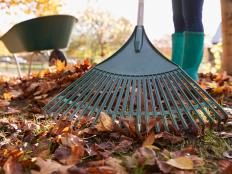6 Best Leaf Blowers of 2024, Tested and Reviewed
The best leaf blower for you depends on how many trees you have, and how much tool maintenance you’re willing to do.


Photo by Sal Vaglica
Our Top Leaf Blower Picks
- Best Battery-Powered: Greenworks BLB489 80-volt Cordless Leaf Blower
- Best Gas: Stihl BG 56 C-E
- Best Budget Gas: Craftsman CMXGAAMA25BL 25cc 2-Cycle Gas Leaf Blower (B215)
- Best Electric: Toro 51621 UltraPlus Blower Vac
- Best Blower and Vacuum: Black + Decker 3-in-1 Leaf Blower & Vacuum BV6000
- Quietest Blower: Ryobi RY404130 40-volt HP Whisper Series Blower
Tested by Sal Vaglica
When fall comes around and the oaks and maples start doing their thing, a leaf blower is a nice complement to your rake. And while you’ll always need a rake, a leaf blower can be a more efficient way to corral piles of leaves, pushing them to the street (if your town offers a vacuum truck), onto a tarp to drag over to a bagging station you’ve set up, or closer to a compost pile (see below to find out why you should be mulching your leaves right on the lawn). And while they’re ideal for fall, blowers can be year-round tools too: Use battery or plug-in versions to spring clean a garage, shed, or the back of an SUV. Running at full throttle a blower is also powerful enough to clear a light coating of snow off the porch or car.
Here we’ve chosen our top leaf blowers according to testing and explain the important considerations you’ll want to keep in mind when shopping. After blowing piles of leaves around, testing for noise level, and sucking up a few bags’ worth from our oaks with the options that worked as vacuums we’ve settled on our best. We tested across three major power sources — rechargeable battery, plug-in electric, and gas.

Photo by Sal Vaglica
How We Tested
To find the best leaf blower we compared eight different options with positive reviews from various brands. We tested each leaf blower for efficacy and speed, noise, and ease of use. For those plug-in electric models that offered a leaf vacuuming and shredding function, we tested that feature too, and timed how long the battery lasted for cordless models. We also took into consideration the included accessories that came in the box.
To test each blower’s functionality, we covered a 10 x 10-foot area with about 2 inches of wet leaves sitting on grass that had been left uncut for weeks. Then we timed how long it took to clear the 10-foot section of most of the leaves while evaluating the tool’s power and ergonomics. Most machines do a fine job of clearing fluffy, dry leaves off a driveway, but moving mounds of wet leaves nestled in tall grass was a more challenging test of how users work with these machines.
We also used a decibel meter app on our smartphone to determine how noisy the blowers were. Held at ear level, while the blower was an arm’s length away — about 40 inches — we ran each tool at full speed and charted the decibels. This is becoming an increasingly important detail as more municipalities cap the decibel level of blowers allowed at certain times of the day. Some towns have prohibited the use of leaf blowers over a certain decibel level or ones that use gas, which tend to be the loudest, so it’s important to check what’s permissible where you live before shopping.
For models that used a rechargeable battery, we timed how long the power pack lasted when the blower ran at full speed. A pair of plug-in electric blowers offered the ability to convert to a leaf shredding vacuum, so we tested how well the devoured piles of wet and dry leaves and how easy their bags were to empty.
- Better at clearing leaves than every other blower we tested, including gas
- Comes with a concentrator nozzle to focus airflow
- Cruise control feature reduces hand fatigue
- Louder than a gas blower
- While the tool is well-balanced, the blower is heavy
The Greenworks BLB489 80-volt is more capable than a lot of gas blowers, albeit with a short runtime. With the 80-volt battery, it offered the most power of any cordless blower in the test, so we were not surprised it bested the models working with 56 and 40-volt platforms. However, when it cleared the 10x10-foot test area of leaves in less than 4 minutes, nearly 2 minutes faster than the best gas blower, it was a testament to how capable modern batteries are when paired with a blower’s linear, axial design. Surprisingly, to clear the wet, matted leaves off the lawn we used the blower on high only sparingly pressing the turbo button.
The assembly was easy and the blower tube connects to the housing with a satisfying click of a green-colored plastic latch, which makes it easy to identify and disassemble the tool for storage. The battery has a fuel gauge built in to give you some idea of how much juice is left and a cruise control feature sets the speed to help reduce hand fatigue. When left to run on high the Greenworks outlasted every other battery-powered option we tested. With enough 80-volt batteries (and a big budget), the Greenworks could be the only blower you need to clear a whole yard’s worth of leaves.
- Power Source Battery
- Voltage 80 volts, nominal; real-life voltage is 72 volts
- Amp Hours 2.5 amp hours
- Weight 11 pounds; 11 ounces
- Length 42 inches
- Decibels 84dB
- Recharge time About 23 minutes
- MPH 170
- CFM 730
- Newtons 22.58
- Warranty 4-year tool warranty; 4-year battery warranty
- Lightweight and comfortable to use
- Semi-automatic choke makes starting easier
- Blower tube adjusts to two lengths
- While it usually started on one or two pulls, it wasn’t always that easy
- The loudest gas blower we tested
- Removing the blower tube is fussier than it has to be
- No cruise control feature on the handle
The Stihl BG 56 C-E was the second most efficient blower in our leaf moving test clearing the test course in 6 minutes. Lightweight and comfortable, the blower is easy to pivot back and forth to clear large swaths of lawn. It was the only gas blower with an air intake on the right side of the housing, which means right-handed users won’t be fighting to keep the tool from trying to suck against your pant leg.
After priming the Stihl Easy2Start system usually gets the engine roaring to life with one or two long pulls of the cord. Once the engine turns over, pulling the throttle moves the choke over automatically, which makes it hard to flood the carburetor and is one less thing you have to remember to manually adjust. Most of the time the engine was easy to start but, initially, it took a few pulls. At an average of 84.7 decibels, it was the loudest among the gas units. We like the blower tube’s easy adjustability, to cater to the heights of users, but you will need a screwdriver if you ever have to take the blower tube off — which just feels over-engineered.
- Power Source Gas
- Engine Size 27.2 cc
- Weight 9 pounds; 5 ounces
- Length 40 inches
- Decibels 84.7dB
- MPH 159
- CFM 412
- Newtons 13
- Warranty 2 years
- Fast-moving stream of air
- Options for nozzle tips
- Cruise control feature reduces hand fatigue
- Started on one or two pulls consistently
- Less efficient at moving leave than our top pick
- Second loudest gas blower in our test
- Will suck against the pant leg when held in the user’s right hand
The Craftsman needed just over 7 minutes to clear our leaf test, but the 200 mph it produced felt noticeably more powerful than the other gas blowers — albeit in a focused narrow beam. While it might be a touch slow when moving heavy, wet leaves, it would perform better clearing leaves off hardscape, moving dry debris, or blasting snow off the roof of a car. We like that it came with a pair of nozzle options, both of which narrow the blast of air to a finer point, and the box included a sample of engine oil. The Craftsman’s engine requires a 40:1 ratio of gas to oil, unlike the more common 50:1, which is also a bit easier to calculate.
One of our biggest complaints about this blower is the air intake’s penchant for sucking in against our pant leg while held in our right hand, which wouldn’t be an issue if you were left-handed. Also, the critical parts of the engine you need to manipulate, like the primer bulb and choke, are exposed to the elements and, during testing, become mucked up with debris. Users will want to keep this area clear to prevent the blower from becoming difficult to start. The Craftsman was the second-loudest gas blower in our test.
- Power Source Gas
- Engine Size 25 cc
- Weight 10 pounds; 12 ounces
- Length 27 inches
- Decibels 83.6dB
- MPH 200
- CFM 430
- Newtons The manufacturer did not provide
- Warranty 2 years
- Less than 9 pounds
- Effective at moving wet leaves when fitted with its oscillating nozzle
- The metal impellor is a more durable leaf shredder than plastic
- Large handle offers plenty of grip options
- Cruise control feature reduces hand fatigue
- The bag isn’t the easiest to empty or comfortable to wear
- Middle of the pack in decibel rating
The Toro was the fastest electric corded leaf blower in the test, taking about 5 minutes to clear the mess of leaves from the yard. The key is to fit it with the oscillating nozzle that sweeps the stream of air left and right for you without needing too much side-to-side movement from your wrist. At under 9 pounds, the tool is easy to carry even when tethered to an extension cord. And you’ll want to keep the instructions as Toro spells out the proper extension cord gauge and length to use to prevent wearing out the motor. The plastic housing has a cord lock feature built into the back, which lessens the chance of a power cord disconnect. The variable speed knob, which isn’t standard on eclectic blowers, is a nice feature.
In the vacuum tests the Toro performed well though it will, like all leaf vacuums, work best with dry material. The aggressive metal impeller never bogged down, but it does develop a layer of wet, shredded debris inside the tool that clogs up the exhaust into the bag. Keep a stick on-hand to clean that out when working with wet leaves. Our biggest complaint is with the bag itself: both how it wears — across the body — and that it’s kind of fussy to empty neatly into a waiting bag through the zipper end. The two other tips that come with the Toro — a power insert and concentrator insert, which both seem to do the same thing — ride inside the main blower tube so switching between the two means disconnecting the tube and sliding the tips in or out, which can be annoying. But for the routine cleaning of a small pile of dry leaves, or in and around a flower beds, it will work just fine.
- Power Source Corded electric
- Motor Draw 12 amps
- Weight 10 pounds; without vacuum kit attached
- Length 39 inches
- Decibels 82.7dB
- MPH 260
- CFM 340
- Newtons 13.4
- Warranty 2 years
- Effective at sucking up wet and dry leaves without much clogging
- The backpack style bag is comfortable to wear and easy to empty
- Large handle offers plenty of grip options
- Lightweight
- Only offers high and low settings
- Switching between blower and vacuum mode requires using a screwdriver, which is annoying
- Slowest plug-in electric blower at moving leaves
The Black + Decker was a bit slower at cleaning up leaves, despite having a reported higher CFM and nearly equal MPH to the Toro. It took nearly 7 minutes to clear our test course of leaves, though it was quieter than its competitor. The tool is easy to hold in blower mode and the tool excels at pushing a concentrated blast of air that’s narrower than the Toro, so it would do well to clear debris off hard surfaces like a patio or walkway. Where the B+D excels at leaf clean-up, despite having the cheaper plastic impeller. The tool didn’t bog down, though it also developed a layer of shredded debris around the outside of the impeller that slowed down how well it pushed leaves into the bag. If you plan on frequent vacuuming the bag is what bested the Toro. The Black + Decker has a backpack-style bag with a corrugated tube connecting to the vacuum. The bag is comfortable to wear and a cinch to empty.
Besides the less-than-stellar leaf-clearing performance, we didn’t love the way the machine converted from blower to vacuum, which required a screwdriver. Also, the blower only operates in low or high mode, so there isn’t a lot of customization, which you might want when vacuuming in and around delicate flower beds.
- Power Source Corded electric
- Motor Draw 12 amps
- Weight 7 pounds; 11 ounces; without vacuum kit attached
- Length 38 inches
- Decibels 82dB
- MPH 260
- CFM 340
- Newtons The manufacturer did not provide
- Warranty 2 years
- Great balance and very comfortable to use
- Has a nozzle you can trim with scissors to control the power of the air flow
- Cruise control feature reduces hand fatigue
- The low powered charger takes a very long time to juice up the battery
- Performance of leaf blowing test wasn’t great on wet leaves
Your neighbors will thank you for using the Ryobi RY404130. During our testing, it was the quietest and about 8 decibels behind the next loudest tool, which might not sound like a lot but decibels work on a logarithmic scale, so the difference is very noticeable. We liked the comfortable handle that with the chunky, rear-mounted battery, makes the blower easy to control and comfortable to use over long stretches. The cruise control feature, located on the right-hand side of the handle, favors righties and is within easy reach.
In practice, the blower wasn’t the most efficient at leaf removal, though it had plenty of power. During testing it took just over 6 minutes to clear our test of wet leaves. The charger packaged with this kit is a 1.5Ah version so it takes about 120 minutes to recharge a battery, which is dreadfully slow. We suggest picking up a second battery to minimize downtime.
- Power Source Battery
- Voltage 40 volts, nominal; real-life voltage is 36 volts
- Amp Hours 4.0 amp hours
- Weight 9 pounds; 8 ounces
- Length 42 inches
- Decibels 75.9dB
- Recharge Time 120 minutes
- Runtime on High About 20 minutes
- MPH 170
- CFM 730
- Newtons The manufacturer did not provide
- Warranty 4-year tool warranty; 4-year battery warranty

Photo by Sal Vaglica
What To Consider When Shopping for a Leaf Blower
Efficiency: There are two specifications you’ll see on just about every leaf blower box: Miles per hour (MPH) and cubic feet per minute (CFM). And it can be confusing to know which one is more important. The truth is balance of both means better performance. However, no manufacturing standard determines where a brand measures these metrics from. Some brands clock the MPH where the tube meets the housing, where the number is often highest, and others from the end of the blower tube, which is more practical. As a consumer, there’s really no way to know. Most recently, the way to evenly compare the power of one blower to the next is to use Netwons. One Newton is required to move something that weighs 1 kilogram 1 meter per second. Unfortunately, a homeowner can’t calculate Newtons on their own, and not all brands test for it or publish the number, as you can tell by our findings. Until Newtons becomes an industry standard, homeowners are left not really knowing which blower is more powerful than the other numerically speaking. (This is why we put them to the test in real life.)
Voltage and Amp Hours: Three of the tools in our test use rechargeable battery packs, each with a unique voltage ranging from 40 to 80 volts and amp hours. When comparing volts it’s important to understand the number on the box, blower, or battery is usually nominal and not what you’ll experience when using the tool. For example, an 80-volt battery, once you load it into the tool and start using it, really delivers 72 volts. Two of the blowers were packaged with batteries that had 4-amp hours, and we fitted the third with a pack we had on hand that had 5-amp hours. Generally, the greater the amp hours, the longer the runtime of the battery at the given voltage. While battery-powered blowers can only operate at their specified voltage — meaning you can only use a tool brand’s 40-volt battery in a blower designed to work with 40 volts — most manufacturers offer batteries at varying amp hours, allowing you to tailor your runtime. Generally, these batteries range from 2 to 12 amp hours at the voltage the tool is designed to use. If you want to extend your runtime, spring for batteries at a higher amp hour, or if you prioritize weight, a battery with fewer amp hours will be easier to hold.
FAQs
Who needs a leaf blower?
The rule of thumb is to consider a leaf blower if you have two or more adult deciduous trees on your property — or if you have fewer, but somehow collect a lot of your neighbor’s leaves. Even if you have a leaf blower, a rake is still an essential tool for fall lawn care.
Which fuel do you need?
If you plan to use a battery-powered leaf blower for more than 25 or 30 minutes, on high, you’ll need to purchase a second battery to avoid serious downtime. That can get expensive. Still, using battery-powered tools means less maintenance, and often the power packs can run other outdoor tools like chainsaws, hedge trimmers, and snow blowers and, in that case, buying a few batteries means added utility. If you have an hour or more of cleaning spread around the yard, then a gas-powered handheld (or backpack) blower is the most practical option. Plug-in electric blowers are low maintenance, easy to use, and lightweight making them a good choice for cleaning up near the house’s outlets where dealing with an extension cord isn’t a big deal.
What can I do with my blown leaves?
Leaves are an excellent source of nutrition for lawns. You can maximize your efficiency by mulching the leaves in place with a lawn mower. Pushing a mower over the leaves (without bagging) severs the bits of debris up, and then they fall down into the lawn between the blades before decomposing. A University of Connecticut study found that mulching a 2-inch thick layer of leaves over your grass adds approximately 3.44 pounds of nitrogen, .46 pounds of phosphorous, and 1.49 pounds of potassium per 1,000 square feet of turf. Another option is to use a blower with a bagging attachment on then spread the bagged leaves over flower beds or in the garden where they’ll return nutrients back to the soil. So before you start blowing leaves around to collect them before bagging, consider keeping them in your yard.

























































